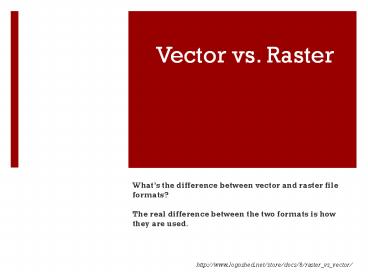Vector vs. Raster PowerPoint PPT Presentation
1 / 6
Title: Vector vs. Raster
1
Vector vs. Raster
- Whats the difference between vector and raster
file formats? - The real difference between the two formats is
how they are used.
http//www.logoshed.net/store/docs/8/raster_vs_vec
tor/
2
Raster artwork (also known as bitmaps)
- are composed of lots of small dots. This lends
itself to photographic or artistic effects
because color gradations can be made very smooth
in a bitmap format. However, bitmap images lose
their clarity when they are increased in size
because the dots get bigger. Take an image that's
10 pixels wide by 10 pixels high, stretch it to
100 x 100 pixels and it looks like it's made of
big squares. - Adobe Photoshop, the industry standard for
digital photo editing, allows users to open and
edit both formats however, when a file is opened
in Photoshop, it can only be edited and saved as
a raster format file. All vector images (such as
Illustrator AI and EPS files) will be rasterized,
that is, converted into the small dots that make
up the raster format.?
File Formats
- Graphic Interchange Format (.GIF)
- Joint Photographers Expert Group (.JPEG, .JPG)
- Tagged Image File Format (.TIFF, .TIF)
- Encapuslated PostScript (.EPS)
3
Vector artwork (sometimes called line art)
- this kind of artwork is made up of lines and
filled areas only, which are mathematically drawn
and calculated (hence the term vector) by the
software you use. They can be stretched in size
without losing any clarity or sharpness. Because
of their mathematical origins, vector images are
readily scalable without distortion. - For vector image editing, use either Adobe
Illustrator or Macromedia Freehand. Either
program will also allow users to import raster
images into their vector files.
File Formats
- Illustrator (.AI)
- Encapuslated PostScript (.EPS)
- PostScript (.PS)
- Windows Meta File (.WMF)
- Flash Movie (.FLA, .SWF)?
Both Illustrator AI and EPS formats allow users
to place raster images within a vector file. The
raster image is not converted to vector format
rather it is simply embedded in the vector file,
and is rendered in raster format.
4
Vector/Raster When and Why?
Vector programs make short work of manipulated
text and any solid color work.
- If you are working with mainly solid color
objects, manipulated text or many small objects,
the clear answer is that a VECTOR program will
save you time. - If you are working with complicated drop shadows,
or other 3D effects, texture or photographs,
RASTER is the correct choice.
For photo work, only a raster program makes sense.
http//www.webreference.com/graphics/column31/4.ht
ml
5
TIFF to the rescue
- Many times vector programs do not have the power
to rasterize images with good results - TIF is a raster program, widely used in print
work, that supports 24 bit color without
degrading quality. You can expect better results
with this format than with uncompressed JPG
files. - Export as TIF and then open in a raster program
to convert to GIF or JPG.
Exported directly to 72 dpi JPG
Exported at 300 dpi in TIFF format. Opened in
Photoshop to reduce resolution and optimize
9.63kb
6
Going the other way - TRACE
- When you have learned to work well with a vector
program, and are comfortable drawing and editing
nodes in paths, you can import the raster image
and place it on its own layer. - Reduce the opacity of the layer to fade the image
back (if available), or draw a semitransparent
white rectangle over the image. - Lock the layer containing the image to be traced.
- Trace the objects on a new layer.
- Tracing partially completed. The blue outline
shows one area that has been traced this area
is now a vector object.
Note Incorporate the raster image into the
vector image if you are not going to need to
resize the image.

